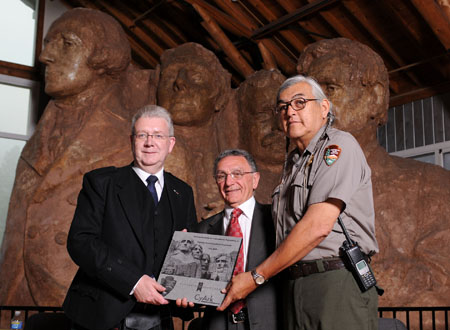On July 3, 2009, as part of the kick-off to celebrate the Fourth of July at Mount Rushmore National Memorial, laser scanning made a bang when CyArk’s Ben Kacyra joined Scottish Culture Minister Michael Russell and Superintendent of Mount Rushmore National Memorial Gerard A. Baker in officiating the signing for a state-of-the-art preservation effort of the renowned monument in South Dakota.
The agreement deserves applause for a number of reasons. One, it provides work—monumental work, shall I say—to local contractors. Rapid City, S.D.-based Wyss Associates and RESPEC Engineering, along with the South Dakota School of Mines and Technology, will work with the National Park Service (Mount Rushmore’s parent), CyArk and Scottish teams to digitally preserve Mount Rushmore. Two, it is yet another example of how savvy industry leaders and equally savvy site overseers see and implement the power of 3D laser scanning technology for preservation efforts—our hats off to these blazers! Of course, we cannot forget the power of the technology itself, which in digital heritage cases such as these, will aid not only marketing efforts for the Mount Rushmore National Memorial and the other partners involved, but it will also make the facility available to a wider community. How’s that?
While the scope of the project is still being developed, the 3D models created from the scanning are proposed to be incorporated on the Web, which will open the accessibility of the park for those who can’t visit it and in a way that will enhance the site experience since visitors can only get so close to the monument. Also proposed is a physical installation to be mounted in the visitor center to allow visitors to get close to the monument virtually. Concrete goals for the project, according to CyArk’s Elizabeth Lee, include applying a base line data set for long-term monitoring of the park structure and its surrounding area, and to have the data integrated into an evolving 3D GIS the park has established. This will also aid the monitoring of the memorial’s face and other assets as well as the general landscape and park as a whole. If an incident results in damage to the sculpture, the 3D models would provide the data necessary to accurately replicate carved surfaces.
International Team Building
But how did this team come together for this effort? CyArk’s Kacyra has certainly established a following over the years, but this agreement teaches us that he’s learned to garner high-level support from his work, as well. Following a string of networking contacts from a previous SPAR conference (yes, a shameless plug) and the Digital Documentation Conference 2009 hosted by Scotland’s Glasgow School of Art Digital Design Studio, Kacyra connected with folks at the National Park Service and with the Scottish Minister of Culture, External Affairs and the Constitution, Michael Russell. Russell was wowed by the application and capabilities of laser scanning, and later committed to scanning the five major heritage preservation sites in Scotland and five more internationally (unofficially dubbed the “Scottish 10”) as part of the CyArk 500 Challenge, an effort to digitally preserve 500 world heritage sites. Kacyra not only got the attention of Russell but honed in on his interest and the experience of his groups—Historic Scotland (Scotland’s heritage agency) and the Glasgow School of Art are no strangers to laser scanning. Glasgow’s School of Art’s Doug Pritchard’s name is synonymous with several Scottish scanning projects, including the Stirling Castle and the Rosslyn Chapel seen in the movie “The Da Vinci Code.” Mount Rushmore will be a larger footprint for Pritchard’s group, which he accepts with excitement: “This is a once-in-a-lifetime opportunity to demonstrate the unique technical skills at the DDS on such [an]internationally significant heritage site,” the NPS news release stated.
Mount Rushmore is to be the first project for the Scottish 10 as a symbol of the international collaboration between the U.S. and Scotland. The CyArk-led project is slated for scanning work in mid-September and will be conducted by a team from Historic Scotland and its partner at the Glasgow School of Art.
“We are indebted to Historic Scotland for their very generous donation of resources and technology to perform the 3D laser documentation,” Kacyra said. “This underscores the international importance of Mount Rushmore and Scotland’s world-class capabilities in this field. We are delighted to have Mount Rushmore and Historic Scotland as active partners in CyArk and to have the Memorial as one of the first heritage sites to be included the CyArk 500.”






